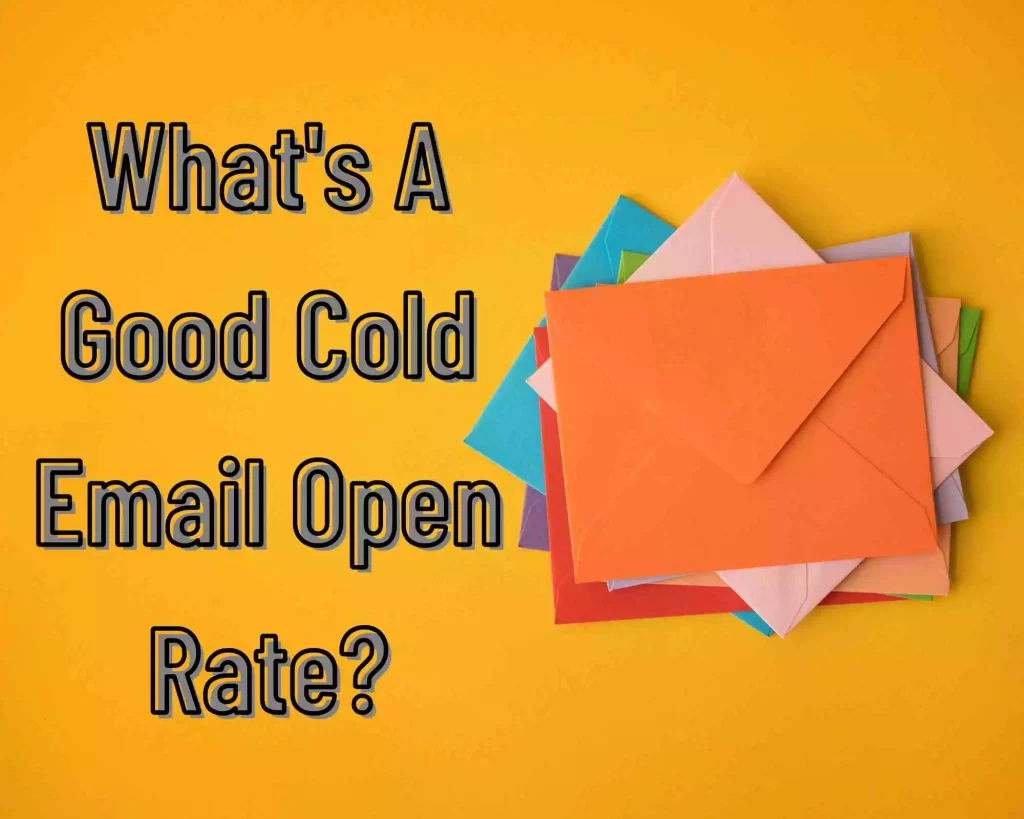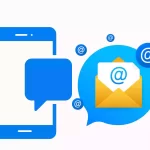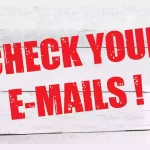Have you ever wonder the question “What’s a good cold email open rate?”
The quick answer is. A good cold email open rate is any open rate between 15-25%. If you achieve 27% or above, consider your campaign a success.
Cold emailing has become a standard technique for companies of all sizes to reach out to prospective clients and market their goods or services in today’s digital era.
However, writing a good cold email is just half the fight. The true problem is ensuring that your email is opened and read by the intended recipient.
This is where the “cold email open rate” notion comes into play.
This post will look at what constitutes a good cold email open rate, the elements that influence it, and the best strategies for increasing it.
Understanding how to evaluate and increase your open rates may be the key to your email marketing success,
Please read our guide on how to get customers to open your emails.
So, without further ado, let’s dive in!
What Is A Cold Email Open Rate?
A cold email open rate is the proportion of receivers who opened your email out of the total number of persons to whom you sent it.
First, it’s important to understand what a cold email is. A cold email is sent to someone who has yet to indicate interest in your product or service. In sales and marketing, cold emails are often used to attract new leads, establish connections, and promote goods or services.
Measuring the open rate is vital because it allows you to determine the performance of your email campaign and offers information on whether your subject line, content and overall strategy are connecting with your target audience.
Cold email open rates may vary based on the industry, audience, and campaign. As a consequence, rather than hoping to meet a universal norm, it is critical to measure your open rates against your prior performance and industry standards.
What’s A Good Open Rate For Cold Email
Let’s talk about what constitutes a good cold email open rate. According to a Mailchimp survey, the average open rate for all sorts of emails across sectors is around 21%.
On the other hand, cold emails have lower open rates than other emails since the receiver has no previous connection or interest in the sender.
So, what exactly is a good open rate for cold emails? According to taskdrive statistics, a decent open rate for a cold email campaign is between 15 and 25%. This may, however, differ based on variables such as the quality of your list, the relevancy of your message, and the sector you’re targeting.
It’s also vital to remember that the open rate is just one of the metrics to monitor in a cold email campaign. Response rate, conversion rate, and total ROI are other key measures. Because the ultimate aim is to produce leads and revenue, a high open rate only sometimes implies a successful campaign.
In short, a good open rate for a cold email campaign is between 15 and 25%. However, this may vary based on a variety of circumstances.
Focus on producing a relevant and tailored message, utilize an engaging subject line, and experiment with various send timings and content to boost your open rate.
What’s A Good Open Rate For Cold B2b Email?
The ideal open rate for a cold B2B email. An open rate of 15-25% is regarded as a fair benchmark for cold B2B emails as a general rule.
It’s crucial to understand that more than a high open rate is needed to determine the effectiveness of your cold email campaign. Other indicators, such as click-through, conversion, and response rates, must be considered when evaluating the efficacy of your campaign.
To get a good open rate for cold emails, keep the following ideas in mind:
What Should You Avoid In A Cold Email?
It would be best if you avoided several things when cold emailing to guarantee that your email is well-received and does not wind up in the recipient’s spam box. Here are a few things to avoid while sending a cold email:
1. Excessive promotional language: Excessive promotional language in a cold email might come off as spammy and turn off the reader.
2. Long paragraphs: Keep your correspondence short and sweet. Long paragraphs might be frightening and make it harder to read your email.
3. Irrelevant information: Ensure your email addresses the recipient’s requirements and interests. If your email does not address the recipient’s concerns, they will most likely disregard it.
4. Personalization: Personalization is essential in a cold email. Send generic emails that do not include the recipient’s name, job title, or firm.
5. Poor grammar and spelling: Make certain that your email is well-written and devoid of grammatical and spelling issues. Otherwise, it may seem unprofessional.
6. Excessive attachments: Avoid including excessive attachments in your cold email. It might be overwhelming, making your email seem suspicious.
7. Pushy language: Avoid using pushy language in your cold email. Instead, focus on building a relationship with the recipient and providing them with value.
You may boost the odds of your email being read and receiving good replies from your target audience by avoiding these common blunders and following best practices for cold emailing.
How Can I Improve My Cold Email Open Rate?
Improving your cold email open rate requires some methods, such as improving your subject line, making sure your email is tailored and sending your email at the appropriate time. The following advice can help you increase the open rate of your cold emails:
1. Create an eye-catching subject line: Because your subject line is the first thing the recipient sees in their inbox, it must stand out. Keep it brief, to the point, and tailored to the receiver.
2. Personalize your email: Personalization may make your email stand out and enhance the likelihood that it will be opened. Use the recipient’s name and explain anything about their industry or function.
3. Keep your email brief and to the point: Long emails are less likely to get read, so keep it brief and to the point. Make it clear what you’re presenting and how it will benefit the receiver.
4. Maintain a professional tone: Maintaining a professional tone might help you develop credibility and trust with the receiver. Avoid using extremely casual or slang terminology.
5. Send your email at the proper time: When it comes to cold emailing, timing is everything. Send emails during work hours and avoid sending emails on weekends or holidays.
6. Segment your email list: Segment your email list depending on the recipient’s interests, requirements, and behavior to generate more targeted and customized emails that are more likely to be opened.
7. Test and optimize: Test and optimize your cold email campaigns on a regular basis. Experiment with various subject lines, email content, and send timings to see what works best for your intended audience.
You can improve your open rates and generate better results in your email marketing efforts by using these best practices and regularly testing and tweaking your cold email campaigns.
What Makes Cold Emails Successful?
Cold emailing is an efficient technique to create leads and establish connections with prospective clients. But it requires a strategic approach to be successful. Several key factors should be considered to increase the likelihood of a positive response.
Personalization is necessary to capture the recipient’s attention and make them feel appreciated. A well-crafted subject line is also essential to ensure that the email is not missed in a full inbox. Furthermore, the email’s content should be brief, useful, and relevant to the recipient’s requirements or interests. Timing is also an important aspect of cold email success. Sending emails within the recipient’s business hours and avoiding weekends and holidays may improve response rates.
Finally, measuring and analyzing data like open rates, response rates, and conversion rates can aid in fine-tuning future cold email campaigns for even greater success.
Conclusion
Now that you’ve learned what a good cold email open rate is. It’s important to note that a good cold email open rate is a key indicator of the success of your email campaign.
While there is no accurate answer for what constitutes a good open rate for cold emails, a benchmark of 15-25% is regarded as a good starting point for B2B emails.
To increase cold email open rates, optimize your subject lines, personalize your email, keep your content concise, and send your email at the appropriate time.
You may generate more targeted and customized emails that are more likely to be opened and achieve greater results by segmenting your email list and testing and optimizing your campaigns.
Finally, the success of your cold email campaign is determined by a variety of criteria, such as the quality of your email list, the relevancy and value of your email content, and the efficacy of your call-to-action.
You may enhance your open rates and obtain greater outcomes in your email marketing efforts by using best practices and consistently updating your email campaigns.
HAPPY EMAILING
Frequently Asked Question
How Many Cold Emails Per Day?
Various aspects, including your goals, available resources, and target audience, should determine the number of cold emails you should send every day.
However, it is typically advisable to begin small and gradually increase your volume over time.
A reasonable general rule to follow is to send no more than 5-15 cold emails per day, especially if you’re starting out.
This allows you to test and enhance your email messages without overburdening your receiver or risking being classified as spam. You may gradually boost the number of emails you send as you learn knowledge and observe great consequences.
How Long Should My Cold Email Be?
The appropriate length of a cold email is 150–200 words or fewer. By doing this, you can make sure that your email isn’t too lengthy or overpowering, increasing the likelihood that your receiver will read the whole thing. But generally speaking, keeping your cold email brief, clear, and focused is ideal.
Keep in mind that the purpose of a cold email is not to immediately close a sale but rather to initiate a dialogue and establish a connection. You may raise the likelihood of a response and subsequent interaction by making your email concise, relevant, and personalized.





